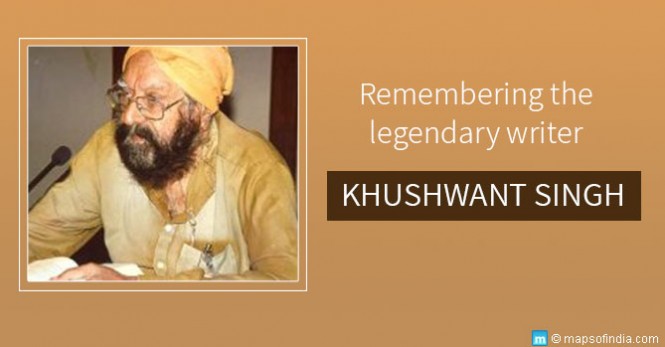Khushwant Singh, a noted writer and journalist, died on March 20, 2014, due to cardiac arrest leaving behind a legacy of wonderful books for literature fanatics. Apart from being an Indian author, lawyer, diplomat, and journalist, Khushwant was a Member of Parliament in the Rajya Sabha, the upper house of the Parliament of India. Born in Hadali, Punjab, Singh worked as the editor of several literary and news magazines and contributed in maintaining peaceful relations between India and Pakistan. He was also bestowed with the Padma Bhushan in 1974 which he returned in 1984 in protest against the operation Blue Star. Later, in 2007, he was awarded the Padma Vibhushan, which is the second-highest civilian award in India.
This maverick writer is best known for his trenchant secularism, sarcasm, and humour. Being an ardent lover of poetry, he wrote an epitaph for himself before his death
Here lies one who spared neither man nor God;
Waste not your tears on him, he was a sod;
Writing nasty things he regarded as great fun;
Thank the Lord he is dead, this son of a gun
His last remains are buried in Hadali School (now in Pakistan). There is a marble plaque installed which has the following words inscribed on it –
This is where my roots are. I have nourished them with tears of nostalgia.
Khushwant Singh was a prolific writer and wrote many books in his lifetime which usually became the talk of the town during his time. Some of his books are evergreen which appeals strongly and mesmerizes the readers.
Let us take a look at the 5 most famous works of this legendary writer-
Train to Pakistan
This book is considered as the magnum opus of this magical writer. In this book, Singh has attempted to depict partition in a humanistic dimension. He has tried to portray emotions and has also tried to emphasize the awe and horror through this novel. He has weaved the novel from a different perspective keeping aside the political chaos surrounding it.
The language of the novel is simple and appealing. The novel is set in Mano Majra, a village on the border of India and Pakistan where the Sikhs and Muslims are apathetic about partition. Later, with further development in the story, we see the village transform into a battlefield and the rising wave of violence engulfing all the love and peace of the village. When a train arrives, carrying the bodies of dead Sikhs in the village, pandemonium is witnessed and it appears that villagers become one part in a hopeless, seemingly endless cycle of bloodshed and history. Singh beautifully explores the themes of love, religion and allegiance that cause mankind to do unthinkable things, things that include both heartbreaking actions and life-affirming ones in this novel.
I Shall never Hear a Nightingale
This is the second novel written by Singh in which he has tried to explore the theme of love, pride, passion, religion, culture and Indianness. The novel is set in British India and is about a magistrate loyal to Britishers and his nationalist and patriotic son who believes in using the gun to drive out the Britishers. Buta Singh, who is a shrewd and wily official working with the British, is the antagonist of the story. His ambitious son is a rebel and is against the foreign master.
Through this composition, Singh has explored the morbidity in domestic relationships. The novel is pitched in religious tension and fraternal strife in India during the times of colonization. A brutal murder takes place which later puts the family in awe and rocks the relationship between father and son, wife and husband.
The Portrait of a Lady: Collected Stories
The collection by Khushwant Singh is thought provoking. “The portrait of a Lady” is the most famous short story by Singh in the collection. He established his reputation as a writer in the London Magazine through this short story. The story is not flamboyant but modest, restrained, and well-crafted. Perhaps, it is a tribute from his side to his beloved grandmother.
Why I Supported The Emergency
This book is a reminiscence of the past but is conceived as a contemporary literature writing. It is a work of non-fiction which consists of essays. As the name suggests, this book is on why he supported the move. The author has put his observations and analysis of events of the times with modesty. Edited by Sheela Reddy, this book is non-fictional and explores profiles of historical figures such as Indira Gandhi, Mahatma Gandhi, Jawaharlal Nehru, Jinnah, and people who strove for the economic development of India like J.R.D. Tata, G.D. Birla, and Sir C.P. Ramaswamy. It is also about poets, writers, and even about the Bandit Queen, Phoolan Devi.
Delhi: A Novel
According to Singh, it took him about 25 years to complete this novel. Delhi: A Novel is set in Delhi and is likely an autobiographic piece by Singh. This book recollects the historic events like the assassination of Mahatma Gandhi and Indira Gandhi. The narrative voice is the author in the novel where he explores the unconventional relationship between him and a hijra (eunuch) named Bhagmati. The novel oscillates back and forth in time.
It starts with narrator returning to Delhi from England and taking a deserted eunuch Bhagmati along with him from a deserted road on a hot Delhi summer noon. The erotic romance starts between them. The eunuch influences his life to the core and later goes on to save him from the mad mobs of the 1984 anti-Sikh riots.
Through this novel, he depicts his versatility as a writer. Humour and a controlled narration make this novel a masterpiece of Singh. It feels like a professional historian explores the history of the great city adjusted with his own misadventures.





